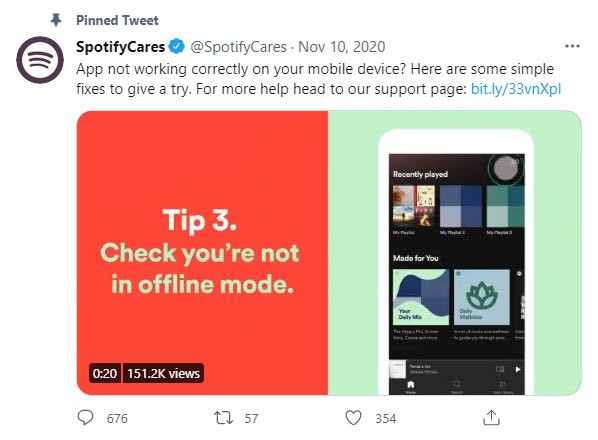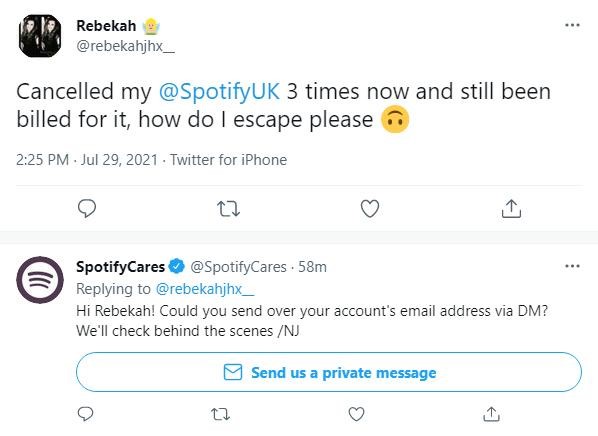4 ways social customer service can help your business

Summary
The following article aims to provide perspective on what social customer support is, its importance, and ways it can help businesses enhance interaction with their customers.
The unprecedented dexterity of the online space allows it a swift expansion to cover and augment more and more aspects of our lives. As customer service is one of the major pillars of any business, it’s only natural that it would get increasingly incorporated into the online as well.
Eventually, customer services had to surface on social media, paving the way for what is now known as social customer care.
By signing up I agree to the Terms of Use and Privacy Policy
What social customer service is
Simply put, social media customer service is a company providing all manner of support to customers via their official social media accounts. Previously, all the support-related communications were done on the company’s grounds in private, whereas now a substantial part of it is going on public platforms where the conversation remains visible to everyone.
With public and private communication mixing in the social media customer support realm, the stakes for businesses are raised. Now, each interaction with a customer has a lasting impact — a glowing peer-to-peer recommendation, devastating review, or an unfavorable sentiment spreading via word-of-mouth.
The shift in customer care channel ownership helps the companies become more accountable and makes customer interaction with them more mobile and honest.

Why social customer service matters
Social media is the next natural evolution step for customer service for many reasons. If we put the general expanse of the Internet and social media aside, there’re still plenty of other points a business should consider when revisiting its approach to customer support operations:
-
Transparency — earlier, customer service was provided non-publicly via the means a business has established. In the era of social customer care, support is provided on public grounds. This transparency allows other current or potential clients to see how a business deals with customer inquiries and issues. So clients can evaluate a business from afar, augmenting the impact of great and disastrous customer support alike.
-
Customer expectation — nowadays, a client expects to receive the company’s assistance by contacting their social accounts, even if these accounts are geared towards outbound marketing only. In the same manner, client expectations pushed the companies to build websites and integrate emails into their work — both are now essential regardless of the industry.
-
Medium of choice for younger generations — the younger audience’s preference will invariably lie with the newest communication medium. As such, social media communication is preferred to emails, online chats, or phone calls. Another thing to note here is how older mediums are perceived as more demanding, time-consuming, and slow in comparison.
-
Operational speed and costs — from a purely operational perspective, running a small team overseeing a company’s social accounts is considerably cheaper than establishing, say, inbound call centers. While phone calls can be more effective at problem resolution, a customer’s issue can often enough be resolved with fewer resources than a phone call demands. It is important to remember that phone calls are time-consuming, more taxing, less flexible, and offer a smaller capacity compared to social media customer service replies.
What’s more, clients can now spectate how the customer support team operates before actually committing to a company or a product. Ultimately, the innate transparency of social customer support results in better service for less effort.
In short, customers push businesses to merge social media and support operations into one. To that effect, social media customer care can be considered the next step in the business-to-client relationship.
How can social media customer service be of use?
There’s more than one goal a business can achieve by properly leveraging the advantages social media customer support brings to the table. With the definition and growing importance of social customer services established, let’s go over its many perks and ways to use them.
Reinforce trust
One of the major differences between traditional customer service and the social customer service we’ve highlighted is transparency. Being an extremely popular public playing field, social media platforms lure businesses away from dealing with customer issues behind the curtains. This publicity allows potential customers to glean into the company’s operations from the outside.
Timely and precise responses to customers’ woes on social media will help you build trust and reinforce your positive image. The consistency in both speed and accuracy of the replies won’t go unnoticed either, as the clients would be able to examine most of the previous support interactions. Additionally, complementing social customer service with traditional one by using call center software can ensure that customer queries are managed efficiently across all channels.
One thing to avoid in social customer care is deleting customers’ posts or comments unless they clearly violate the guidelines you have established, or are spammy. Deleting inconvenient inquiries won’t go unnoticed, and will surely plummet the confidence people might have in your business. Remember that trust is hard to gain and easy to lose.
Identify Customer Pain Points
The pain points clients might have with your business can be multifaceted — they can relate to the financial side of things, the productivity cost of your solution or the guidance customers receive along their journey with you. Therefore, it stands to reason that actively using social media in your work can help quickly uncover and deal with these pain points.
With that in mind, manually scouring the vasts of social media for customer woes is tedious at best. This is where a social monitoring tool would come in handy. The social customer service team can use such a tool to monitor what people are saying about the entire industry you’re in, identify common stumbling points, and relay that information upwards to try and find a solution.
On top of that, a social listening tool can be used to monitor what is being said about you and your closest competitors specifically. This information can prove invaluable in deciding the focus of further development, understanding what you’re doing well and where you’re lacking alike.

Valuable customer insights
The transparency factor of taking your customer support operations to social media can contribute to more than trust gain or pain points discovery. For instance, an issue brought forward by one customer may incite a conversation with your other like-minded customers — something not seen on other customer care channels. Naturally, a variety of insights can be gleaned whenever multiple customers speak up.
These insights can shed light on a technical issue that has eluded your team, point to problematic behavior of your business partners, highlight an overarching design problem, or help understand the overall sentiment over specific aspects of your work, the company, or the industry in general.
The social media customer support environment organically lends itself to feedback by enabling customers to publicly voice their concerns and “piggyback” upon the feedback of others.
By signing up I agree to the Terms of Use and Privacy Policy
Handle Negative Complaints and Reviews
In the context of traditional support channels, review handling was more of a marketing rather than support responsibility, as it was more about the reputation rather than any imminent issue. But much like the other aspects of customer service, this has changed with the rise of social customer care.
Today, people tend to post next to everything on social media, so chances are someone is posting about their experience with your company. Whenever the post is negative and the client also happens to tag you, social customer support can easily intervene to mitigate its impact. It’s also possible that the support team manages to resolve the issue altogether, potentially morphing the old review into the positive key.
While discovering posts you’re tagged on is trivial, many clients would often forgo tagging you, allowing a hypothetical issue to escape your attention. Social listening tools, like Awario, can help mitigate that issue as well. Implementing social monitoring prevents negative posts from falling through the cracks, allowing your social customer service team to find all mentions of your company, regardless of whether you were tagged or not.

Tips for great social customer service
With the perks of turning your support operations to the ways of social media laid bare, we’d like to offer some bits and pieces of advice to go along with it. All of them are easy to follow and are guaranteed to make your social customer experience better.
Track relevant conversations
It is important to realize that people are going to talk about your business outside of the official channels and without tagging. There’s a very good chance these posts warrant a customer support team intervention, but since you haven’t been tagged they are apt to fly under the radar. As such, finding these hidden conversations is imperative to your success with social media customer care.
As manual tracking of brand mentions on any social media platform is both time-consuming and ineffective, adding a social listening tool to your arsenal will prove invaluable to discovering the brand mentions.

Keep marketing and support separate
A lot of businesses use their official social media accounts to run outbound marketing. Still, your marketing team is likely to be less effective with customer support inquiries that they will invariably receive. For that reason, you should consider creating a separate account to manage social customer care.
Doing so helps keep your social channels clean and easy to comprehend, as marketing will be neatly separated from most support-related queries. What’s more, this would boost the performance of both marketing and support teams, as their content will not be mixed up.
Make sure you mention your social customer support account’s handle in your primary account’s bio. While it might not prevent support-related inquiries from appearing in your marketing team’s inbox, it will be much easier to direct these people to the appropriate channel.

Be ready for inquiries
The issues the customer support team deals with are often similar, if not identical. With that in mind, it is a great idea to draft some manner of an information resource to cover the most popular issues and questions.
Creating this kind of resource would help manage the volume of requests your social media customer service team deals with, accelerating the process and freeing up resources for more demanding issues.
On top of that, you can post a plethora of content to help the social customer experience. This includes various educational content about your product or service’s every nook and cranny, how-tos, guides, or status updates whenever something is wrong on your end. This is where a social media management software solution comes in useful. It allows you to schedule and handle content across multiple networks for each specific social media campaign. As such, you can manage marketing and customer support accounts under the same roof while still keeping them separate.

Respond always, respond quickly
Seemingly a no-brainer, a staple in customer care of any caliber, this rule gets overlooked every now and again.
People who message a brand on social media might or might not be its clients. However, accurately answering the queries posted on your social pages promotes your company’s image and shows potential customers that you care about their woes. This just might be the edge required to secure new clientele. On the flipside, not answering at all or giving sloppy responses is likely to drive customers to your competitors.
Another important factor to consider is the response time. Providing replies that are both fast and accurate is a surefire way to win a customer’s heart while being too slow makes you look indifferent to your customers’ troubles. At the same time, a social customer care team might not be online at all times, and there’s nothing wrong with that. All you need to do is set adequate expectations for the clients:
-
Make your availability hours clear — post them in bio, for example.
-
Let the clients know when you’ll be back — set up an automated message outlining when the team is able to take the inquiry.
-
Provide means to get to other customer service channels — an email address or phone number would do great.
-
Link to your help center — reference the self-service center in your pinned post.

Keep sensitive data private
Depending on what type of business you are in, your social customer support team might require sensitive details to be disclosed in order to resolve an issue, like the 4 last digits of a card number. There can be other kinds of inquiries inviting a more confidential approach, so don’t hesitate to use direct messaging for social media customer care.
Doing so, however, takes away from the transparency factor social customer service boasts. To get the best of both worlds, you can post public comments urging the client to check their DMs. More than that, it showcases to the outside spectators that you did actually respond, albeit in private.

Before you go
Broadening support operations to official social media accounts is expected of most businesses for convenience, speed, and transparency reasons. Luckily, training your customer support team to deal with social media shouldn’t prove much trouble at all.
Social customer service is here to stay, so it would be unwise to ignore its many perks. And if there’s one thing to help you see these perks realized to their fullest, it would be social listening tools not unlike Awario. What’s there to wait for? Start tracking conversations around your niche today!













